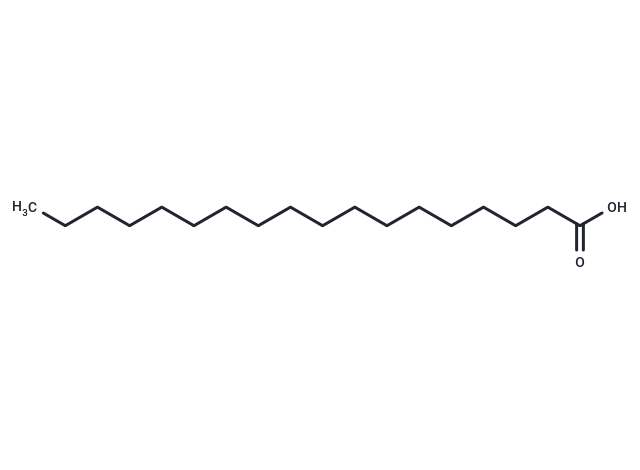- Remove All
 Your shopping cart is currently empty
Your shopping cart is currently empty
Shopping Cart
Stearic acid
Catalog No. T2P2923Cas No. 57-11-4
Alias Octadecanoic acid, Cetylacetic acid
1. Stearic acid (Cetylacetic acid) can reduce metastatic tumor burden. 2. Stearic acid leads to dramatically reduced visceral fat likely by causing the apoptosis of preadipocytes. 3. Stearic acid and its derivatives have been used as gelators in food and pharmaceutical gel formulations. 4. Stearic acid is a potent phosphatase 1B inhibitor, possibly causing an enhancement in the insulin receptor signaling to stimulate glucose uptake into adipocytes. 5. Stearic acid has the potential to increase dry matter intake and yields of milk and milk components, without affecting conversion of feed to milk, body condition score, or body weight.

Stearic acid
Catalog No. T2P2923Alias Octadecanoic acid, Cetylacetic acidCas No. 57-11-4
1. Stearic acid (Cetylacetic acid) can reduce metastatic tumor burden. 2. Stearic acid leads to dramatically reduced visceral fat likely by causing the apoptosis of preadipocytes. 3. Stearic acid and its derivatives have been used as gelators in food and pharmaceutical gel formulations. 4. Stearic acid is a potent phosphatase 1B inhibitor, possibly causing an enhancement in the insulin receptor signaling to stimulate glucose uptake into adipocytes. 5. Stearic acid has the potential to increase dry matter intake and yields of milk and milk components, without affecting conversion of feed to milk, body condition score, or body weight.
| Pack Size | Price | Availability | Quantity |
|---|---|---|---|
| 5 g | $30 | In Stock | |
| 10 g | $50 | In Stock | |
| 25 g | $82 | In Stock | |
| 50 g | $119 | In Stock | |
| 1 mL x 10 mM (in DMSO) | $29 | In Stock |
Bulk & Custom
Add to Cart
Questions
View MoreSelect Batch
Purity:99.31%
Contact us for more batch information
All TargetMol products are for research purposes only and cannot be used for human consumption. We do not provide products or services to individuals. Please comply with the intended use and do not use TargetMol products for any other purpose.Product Introduction
Bioactivity
Chemical Properties
| Description | 1. Stearic acid (Cetylacetic acid) can reduce metastatic tumor burden. 2. Stearic acid leads to dramatically reduced visceral fat likely by causing the apoptosis of preadipocytes. 3. Stearic acid and its derivatives have been used as gelators in food and pharmaceutical gel formulations. 4. Stearic acid is a potent phosphatase 1B inhibitor, possibly causing an enhancement in the insulin receptor signaling to stimulate glucose uptake into adipocytes. 5. Stearic acid has the potential to increase dry matter intake and yields of milk and milk components, without affecting conversion of feed to milk, body condition score, or body weight. |
| Alias | Octadecanoic acid, Cetylacetic acid |
| Molecular Weight | 284.48 |
| Formula | C18H36O2 |
| Cas No. | 57-11-4 |
| Smiles | CCCCCCCCCCCCCCCCCC(O)=O |
| Relative Density. | 0.87 g/cm3. |
Storage & Solubility Information
| Storage | Powder: -20°C for 3 years | In solvent: -80°C for 1 year | Shipping with blue ice. | ||||||||||||||||||||||||||||||
| Solubility Information | DMSO: 16.67 mg/mL (58.59 mM), Sonication is recommended. | ||||||||||||||||||||||||||||||
Solution Preparation Table | |||||||||||||||||||||||||||||||
DMSO
| |||||||||||||||||||||||||||||||
Sci Citations
Calculator
In Vivo Formulation Calculator (Clear solution)
Please enter your animal experiment information in the following box and click Calculate to obtain the mother liquor preparation method and in vivo formula preparation method:
Mother liquor preparation method: 2 mg of drug dissolved in 50 μL DMSO (mother liquor concentration of 40 mg/mL), if you need to configure a concentration that exceeds the solubility of the product, please contact us first.
(mother liquor concentration of 40 mg/mL), if you need to configure a concentration that exceeds the solubility of the product, please contact us first.
Preparation method for in vivo formula: Take 50 μL DMSO main solution, add 300 μLPEG300
main solution, add 300 μLPEG300 mix well and clarify, then add 50 more μL Tween 80, mix well and clarify, then add 600 more μLddH2O
mix well and clarify, then add 50 more μL Tween 80, mix well and clarify, then add 600 more μLddH2O mix well and clarify
mix well and clarify
For Reference Only. Please develop an appropriate dissolution method based on your laboratory animals and route of administration.
Dose Conversion
You can also refer to dose conversion for different animals. More Dose Conversion
Tech Support
Please see Inhibitor Handling Instructions for more frequently ask questions. Topics include: how to prepare stock solutions, how to store products, and cautions on cell-based assays & animal experiments, etc
Related Tags: buy Stearic acid | purchase Stearic acid | Stearic acid cost | order Stearic acid | Stearic acid chemical structure | Stearic acid formula | Stearic acid molecular weight

Copyright © 2015-2025 TargetMol Chemicals Inc. All Rights Reserved.



